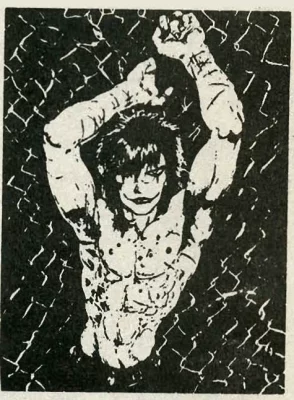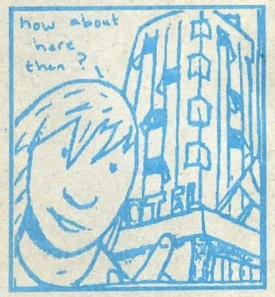
Comic Review: August 1992
Archived
While the comics industry continues to be dominated by superhero material that is generally crap, there are more comics embracing a “new wave” philosophy of being “different” and experimental than at any time. Below are reviewed three recent examples of this philosophy, but there are numerous worthy comics out there (some of which have been previously reviewed), if you know where to look. Happy hunting!
The Adventures of Tad Martin
The brainchild of Al Frank, Tad Martin bills itself (tongue firmly in cheek) as “the official comic of the 1992 punk Olympics.” The result, unfortunately, is a hodge-podge of interesting, but unsatisfying ideas.
The current issue, #3, is highlighted by a cover by EIGHTBALL creator Dan Clowes, but the interior is a let-down compared to that auspicious decoration. The first tale, “It’s Mine” features Lil’ Tad (who, it should be explained, is Iabeled “Average American Teenager,” but obviously is not, given his ghoulish appearance and ghoulish attitude) in a fairly amusing satire on childhood experience told through a series of altered photos from the 1950s. Seems Lil’ Tad has had just about enough bullying from others and decides to fight back. While the story is disjointed, the point being made is sufficient to make this negligible.
If only the rest of the issue were as interesting. though Frank has evidently embraced the notion that different is better, and reaches deep within his psyche to find material that is empty and devoid of intent and meaning. “Tricky” details Tad’s relationship with ti-.also-named character, and while there could have been some merit to the exploration of a neurotic love, it is watered by aimlessness. Even worse is “Manslan,” however, which tries to be dream-like but succeeds in being only obscure.
The downfall to TAD MARTIN lies in Frank’s lack of narrative skills. There is probably a wealth of ideas that the series could explore, but it is lost in the forced attempts at cleverness and artsiness. Frank’s art is, surprisingly, rough but charming in its own way–almost a cross between Bill Sienkiewicz and Fiona Smyth–but it is too inconsistent at times.
Overall, TAD MARTIN seems to be a wasted opportunity. Creator Frank could be a talent to watch in the future. but only if he jettisons his notions of being “punk.” The only real saving grace to the comic is the autobiographical (?) one-page “The Murray Years.” Perhaps Frank should consider that ouvre instead? (B&W. $2.50)
The Crow
After years of waiting, fans of James O’Barr‘s tale of revenge from beyond the grave, THE CROW, can finally read the entire work, thanks to the recently completed three-part series from Tundra Press.

As stated, this tale is more or less about exacting vengeance. In this case, a young man who was murdered (along with his girlfriend) for kicks by scum is reborn and spends the series killing the perpetrators and considering lofty ideals.
Volume 3 (subtitled “Death”) features the denouement, as the protagonist (the Crow) has managed to terrorize and exterminate many of his victims and now seeks to punish T-Bird, who led the actions against the Crow. Unlike typical revenge tales, though, creator O’Barr seeks to inject some spirituality and philosophy as the Crow spouts Biblical phrases while committing heinous and bloody acts.
Is it successful? That’s up to the reader to decide. While O’Barr’s approach does have its merits, it comes off as attempted, but botched ingenuity. The story is so firmly entrenched in melodrama that it becomes, at times, almost unintentionally funny when trying to be meaningful. If O’Barr had left out some of the flashbacks in favor of genuine characterization, the results would have been much more satisfactory. Some attempted moves in this direction, like the Crow’s friendship with a young girl, Sherri, is sabotaged by clumsy dialogue, so one suspects the author knows his limits.
The series is fascinating to view for the development in O’Barr’s art, though. While the illustration is merely good at the start, by the conclusion O’Barr has grown immeasurably. If only his writing had grown similarly.…
So, while this reviewer admires the growth in O’Barr’s rendering, he also wishes the story had grown. As it is, this tale of darkness, mixed with morality, only makes him eager to see what O’Barr does next. (B&W, $4.95).

Way Out Strips
Eschewing typical comics illustration techniques, London’s Carol Swain employs charcoal to produce a fascinating look that is showcased in Way Out Strips.
The debut issue features five tales that share little in common other than a kind of displacement, in that they deal with disenfranchised and disaffected humans. The stories also vary in quality from good to meaningless.
Best is the opening “Jig and Reel,” featuring punks at a concert. Similarly, the nearly wordless “Terrific Island” is undeniably charming.
But “In My Neighbourhood” and “‘B’ Movie” display Swain’s techniques. While the art is fairly simple, it is also different and evocative, which translates well on the page. In addition, panel layout is composed much like a classic example of cinematography, with establishing shots, unusual angles, and zooms which make the results much more powerful.
Also, unnecessary dialogue is left out, leaving the remaining words and pictures to tell the story, an admirable trait other writers should follow.
But, as remarked upon earlier, much of Swain’s work is devoid of impact and intent. In the introduction, Paul Gravett mentioned Swain’s interest in Jack Kerouac and movie directors Terrence Malick and Wim Wenders. However, her admiration evidently does not entail absorption of their vision and scope. While she them in several ways, she lacks their impact and intuition.
It could just be that the stories chosen for this issue were mediocre, and in that case I look forward to seeing what issue 2 will bring. But while Way Out Strips is nice to look at is a letdown, considering it could be so much more. (B&W, $2.50).
Check out more from the SLUG Archives:
Comics: April 1992
Comic Review: May 1992